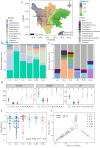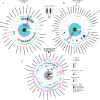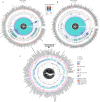A novel framework unveiling the importance of heterogeneous selection and drift on the community structure of symbiotic microbial indicator taxa across altitudinal gradients in amphibians
- PMID: 39772705
- PMCID: PMC11792505
- DOI: 10.1128/spectrum.04192-23
A novel framework unveiling the importance of heterogeneous selection and drift on the community structure of symbiotic microbial indicator taxa across altitudinal gradients in amphibians
Abstract
Existing analytical frameworks for community assembly have a noticeable knowledge gap, lacking a comprehensive assessment of the relative contributions of individual or grouped microbial distinct sampling units (DSUs) and distinct taxonomic units (DTUs) to each mechanism. Here, we propose a comprehensive framework for identifying DTUs/DSUs that remarkably contribute to the various mechanisms sustaining microbial community structure. Amphibian symbiotic microbes along an altitudinal gradient from Sichuan Province, China, were employed to examine the proposed statistical framework. In different altitude groups, we found that heterogeneous selection governed the community structure of symbiotic microbes across DSUs, while stochastic processes tended to increase with altitude. For DTUs at phylum and family levels, drift emerged as the dominant mechanism driving the community structure in the most symbiotic microbial taxa, while heterogeneous selection governs the most dominant or indicator taxa. Notably, the relative contribution of heterogeneous selection was significantly positively correlated with the relative abundance and niche breadth of taxa, and negatively correlated with drift. We also detected that community assembly processes remarkably regulate the structure of symbiotic microbial communities and their correlation with environmental variables. Altogether, our modeling framework is a robust and valuable tool that further enlarges our insight into microbiota community assembly.
Importance: Distinguishing the drivers regulating microbial community assembly is essential in microbial ecology. We propose a novel modeling framework to partition the relative contributions of each individual or group of microbial DSUs and DTUs into different underpinning mechanisms. An empirical study on amphibian symbiotic microbes notably enlarges insight into community assembly patterns in the herpetological symbiotic ecosystem and demonstrates that the proposed statistical framework is an informative and sturdy tool to quantify microbial assembly processes at both levels of DSUs and DTUs. More importantly, our proposed modeling framework can provide in-depth insights into microbiota community assembly within the intricate tripartite host-environment-microbe relationship.
Keywords: community assemblage; indicator taxa analysis; natural selection; neutral theory; taxon-specific effect; turnover.
Conflict of interest statement
The authors declare no conflict of interest.
Figures






Similar articles
-
Research Status and Prospect of Amphibian Symbiotic Microbiota.Animals (Basel). 2025 Mar 25;15(7):934. doi: 10.3390/ani15070934. Animals (Basel). 2025. PMID: 40218328 Free PMC article. Review.
-
Seasonal variation significantly influenced the stochasticity of community assembly of amphibian symbiotic bacteria.Environ Microbiol. 2022 Dec;24(12):5734-5748. doi: 10.1111/1462-2920.16224. Epub 2022 Oct 10. Environ Microbiol. 2022. PMID: 36156840
-
Fungal infection alters the selection, dispersal and drift processes structuring the amphibian skin microbiome.Ecol Lett. 2020 Jan;23(1):88-98. doi: 10.1111/ele.13414. Epub 2019 Oct 21. Ecol Lett. 2020. PMID: 31637835
-
Changes in the community structure of the symbiotic microbes of wild amphibians from the eastern edge of the Tibetan Plateau.Microbiologyopen. 2020 Apr;9(4):e1004. doi: 10.1002/mbo3.1004. Epub 2020 Feb 11. Microbiologyopen. 2020. PMID: 32045512 Free PMC article.
-
Host Species and Geography Differentiate Honeybee Gut Bacterial Communities by Changing the Relative Contribution of Community Assembly Processes.mBio. 2021 Jun 29;12(3):e0075121. doi: 10.1128/mBio.00751-21. Epub 2021 Jun 1. mBio. 2021. PMID: 34061602 Free PMC article.
Cited by
-
Research Status and Prospect of Amphibian Symbiotic Microbiota.Animals (Basel). 2025 Mar 25;15(7):934. doi: 10.3390/ani15070934. Animals (Basel). 2025. PMID: 40218328 Free PMC article. Review.
References
MeSH terms
Grants and funding
LinkOut - more resources
Full Text Sources
Miscellaneous

